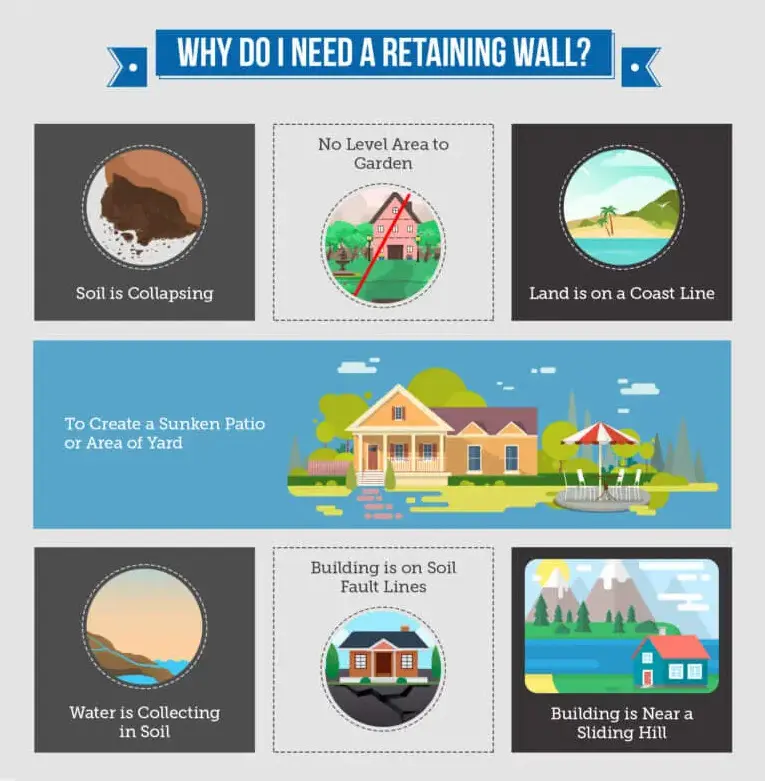Why Do You Need a Retaining Wall?
A retaining wall isn't just a structural element in the landscape design; it's a complex solution to several issues homeowners might face. Property owners grappling with soil erosion can use retaining walls to enhance their outdoor living spaces or safeguard their property against structural damage.
A well-designed retaining wall is the cornerstone of preserving and enhancing property value while making the landscape more livable and enjoyable. These wall types are especially helpful for creating flat outdoor spaces for properties built on slopes or hills.
Gabion Supply has a knowledgeable team that provides top-quality materials for wall projects, ensuring a solid foundation and impeccable curb appeal for outdoor spaces. We provide an in-depth outline to help property owners understand when to consider retaining walls.

Soil Is Collapsing
Soil erosion is a silent menace that gradually weakens the integrity of land. That's why we encourage property owners who notice signs of collapsing soil to address the issue promptly to prevent future costly repairs. One purpose of a retaining wall is to hold back soil, especially if the soil slopes downward. These walls function as barriers, mitigating water runoff and preventing downhill erosion.
Our expert team at Gabion Supply offers a drainage solution that integrates seamlessly with the landscape, preserving usable land while preventing property damage. Our retaining wall systems are ideally suited for erosion control applications. We use standard design methods to ensure they meet industry standards.
No Level Area to Garden
Building retaining walls helps divert rain and groundwater while creating usable space that homeowners can use for other projects. These walls create tiered sections that provide flat areas for horticultural aspirations, as well as outdoor furniture, grills and accessories. A properly-installed retaining wall can turn a sloped yard into usable space, ensuring the garden is beautiful and structurally sound.
Land Is on a Coastline
Owning land along the coastline brings the threat of erosion, saltwater intrusion and storm surges. Coastal lands are exposed to constant ebb and tide flows that, over time, can lead to significant land loss. This can jeopardize structures and drastically alter precious landscapes.
A well-constructed retaining wall is indispensable to mitigate these risks and preserve the integrity of the property. It acts as a barrier, shielding coastal land from aggressive waves and preventing the gradual washing away of soil.
To Create a Sunken Patio
Creating a sunken patio involves excavating a portion of the land to establish a lower level for seating and other landscape projects. However, this process can destabilize the surrounding soil, exposing the area to collapse or erosion. A well-constructed retaining wall counters this destabilization, holding back the soil and providing a sturdy perimeter that protects and defines the sunken oasis.
Another critical consideration is water damage. Without proper draining, rainwater and groundwater can pool in the sunken area, resulting in water damage and soggy, unusable land. A retaining wall serves a functional purpose while using the space in a creative way. Our professional team uses industry-leading retaining wall materials to ensure the sunken patio remains dry while redirecting rain and groundwater from the sunken land.
Water Collects in Soil
If the property is at risk of flooding, installing a retaining wall to protect the land is necessary. Retaining walls are built with drainage stones that prevent water from building up in the soil, allowing it to flow properly without causing drainage issues that may result in structural damage. Property owners no longer worry about floods or mud ruining their landscape.
Building Is on Soil Fault Lines
Building on soil fault lines requires a lot of consideration and robust solutions that only professionals can provide. Structural issues, such as erosion, may not seem threatening during construction but could damage the property under the right conditions.
Homes located downhill from soil fault lines should install retaining walls to provide stability and peace of mind, knowing the structure is anchored on a solid foundation. Our team understands the intricacies of constructing property on challenging terrain and provides guidance and materials to secure property against uncertainties resulting from soil fault lines.
Building Is Near a Sliding Hill
If the property is adjacent to a sliding hill, the risk of land erosion and subsequent damage can be daunting. Buildings sitting on steep uphills or downhills often lose the use of the sloped land without a proper retaining wall installed. Homeowners would also have difficulty growing vegetation or cutting grass on the sloped land.
A retaining wall helps mitigate severe slopes, opening more possibilities for planting gardens, shrubs and trees. Customers can even request to add stairs to the wall to improve accessibility to front entrances and other outdoor areas.
Retaining walls function as formidable barriers that protect the land from encroachment by stabilizing the slope and controlling water runoff. Our retaining wall installation process safeguards property while reclaiming and enhancing outdoor space, allowing for other landscape designs in previously unusable land.
Get in Touch With Us
Whether you're contending with flooding, soil erosion or soil fault lines, a retaining wall is a versatile solution that secures your property while addressing many landscape issues. Our professional and knowledgeable team installs customized retaining walls after assessing the client's needs and developing a solution that best meets their budget.
We work with clients to choose the best materials and designs that meet their landscaping needs. Contact us today to begin your retaining wall installation.
